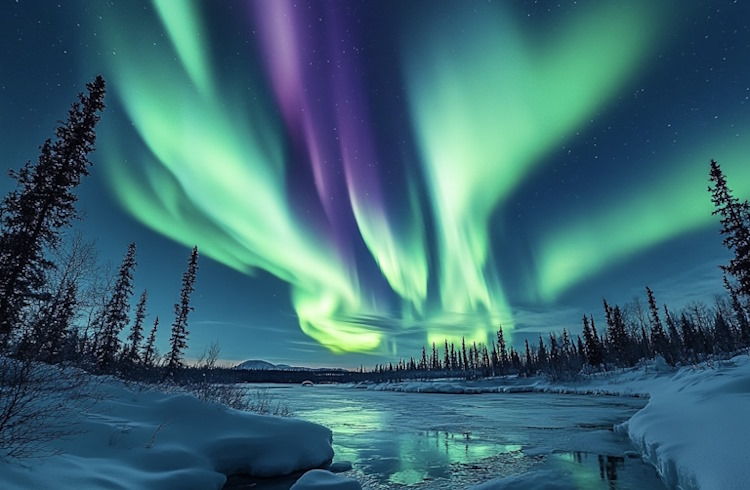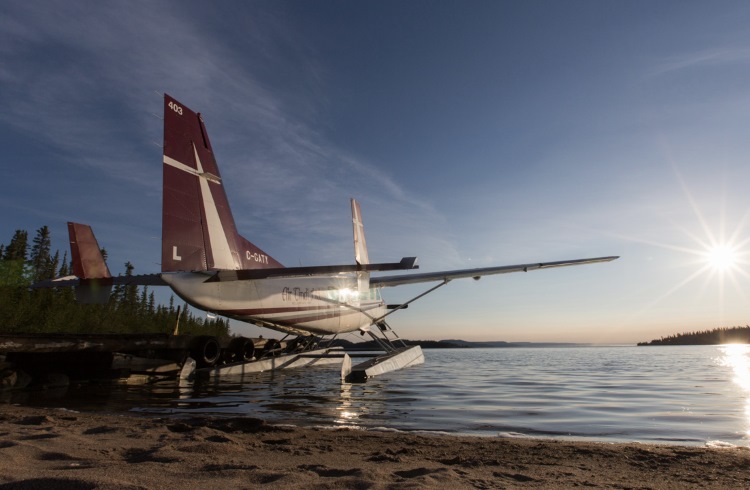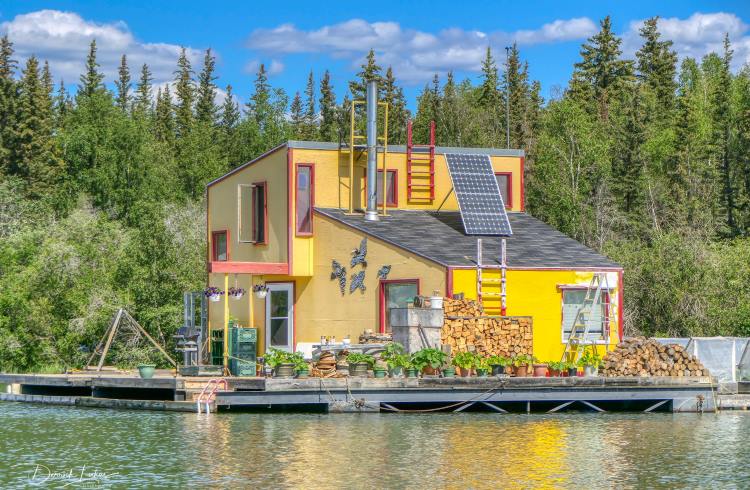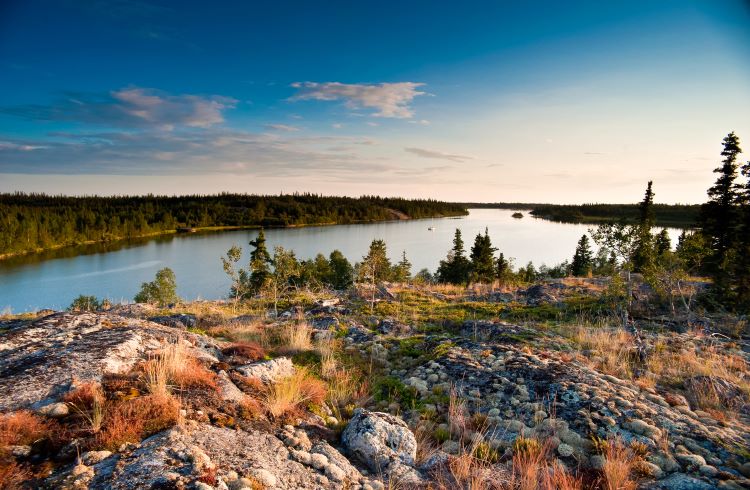Discover Thaidene Nëné, Canada’s Newest National Park
Co-founded and co-managed by the Indigenous peoples who first called this region home, the new park on the Northwest Territories’ Great Slave Lake helps preserve traditional ways of life as well as the landscape.
 Photo © Joseph Furey
Photo © Joseph Furey
It may have taken half a century to gestate, but in 2019 Canada was finally delivered of its newest national park, the Thaidene Nëné National Park Reserve. In Łutsël K’é, a First Nation village of fewer than 400 people reachable only by boat, plane, or snowmobile, representatives from the Łutsël K’é Dene First Nation, the Deninu Kųę́ First Nation, Yellowknives Dene First Nation, Parks Canada, and the Northwest Territories government formally signed the park into existence.
“Groundbreaking” doesn’t begin to cover it. “Revolutionary” gets closer. The establishment of Thaidene Nëné (“land of the ancestors” in the Dënesųłıné language) represents a new vision of conservation, one predicated on respect for ancestral territory and dedicated to preserving traditional ways of life, advancing reconciliation with Indigenous peoples, as well as helping to tackle climate change and biodiversity loss.
- Protecting wildlife and Indigenous traditions
- Catching fish and the Northern Lights near Yellowknife
- First Nations sites and Canadian history
Protecting wildlife and Indigenous traditions
Sitting on the eastern arm of Great Slave Lake, the deepest lake in North America, the reserve – enclosed within the Thaidene Nëné Indigenous Protected Area – covers 3.5 million acres of nationally significant ecosystems, from boreal forest to freshwater. The landscape is home to healthy numbers of musk ox, moose, grizzly and black bear, wolverine, Arctic fox, marten, and two subspecies of caribou, and provides a breeding refuge for many migratory birds.
It is co-managed by the federal and territorial governments and the First Nation peoples (the signatories of the agreement plus the Northwest Territory Métis Nation) who since time immemorial have paddled its waters, roamed its ridges, and camped in its bays. The Ni Hat’ni Dene Rangers, a network of Łutsël K’é residents, serve as guardians during the summer months, guiding visitors, keeping a close eye on the environment, maintaining its natural beauty and culturally important sites, and mentoring and educating younger generations.
To that end, the federal government has promised to invest CAD $40 million in the park in its first 12 years; and the Łutsël K’é Dene First Nation has set up a $30 million trust that is expected to generate around $1 million in interest a year, which can be used to support the management of the protected area. In the spring of last year, the first disbursement from the fund was made to the community.
For an introduction to the reserve’s rewards, there’s Frontier Lodge, the self-styled “gateway to Thaidene Nëné” (it’s a mere 15-minute boat ride to the park boundary). Operated by the Łutsël K’é Dene First Nation, its log cabins sleep up to 30 guests and it lays on a variety of authentic cultural experiences: guided fishing trips; a weekend of traditional camping, cooking, and storytelling; a women’s wellness retreat, involving morning yoga, wildlife-spotting hikes, drum dances, folk medicine workshops, and healing ceremonies; and a Northern Lights show (by September you are practically guaranteed nightly performances).

Parks Canada, an agency of the Canadian government, first identified the area’s potential as a national park in the late 1960s, but its proposal was turned down by Łutsël K’é Dene First Nation elders, who feared the designation would lead to their people’s exclusion from their ancestral territories and prevent them from exercising their rights to hunt, fish, collect medicinal plants, and to gather and perform ceremonies at sites of spiritual import. Their reluctance was more than understandable – at the time, Indigenous children were still being taken away from their families and forced to attend state-funded Christian schools that promoted cultural cleansing.
Catching fish and the Northern Lights near Yellowknife
I first experienced the Northwest Territories on a visit to Yellowknife, its capital on the north shore of Great Slave Lake, a mining town built on gold in the 1930s and kept going by diamonds (it’s also where you can get flights to Łutsël K’é – the journey takes about 45 minutes). I was writing a travel piece about the choicest places to catch the aurora borealis, and the city was kind enough to extend me an invention to see for myself (as Margot Kidder, who played the reporter Lois Lane in the Superman movies, was born in Yellowknife, I felt in good company).
Getting to watch bands of green and purple flex and caper across the sky for three nights was enormously gratifying, and the gaily hued houseboats in Yellowknife Bay added interest, but the tourist bureau also flew me to a fishing lodge on Christie Bay, where I was told lake trout, coney, Arctic grayling and northern pike would provide me with some of best freshwater angling I’ve ever experienced, both in terms of sport (big, well-exercised specimens with plenty of fight), spectacular setting and the knowledge that the bay has hidden depths (submarine canyons that inexplicably drop more than 2,000ft / 610m below the surface). The rumors were true. In fact, Thaidene Nëné is where northern sportfishing began, in 1938, when a businessman from Manitoba founded Plummer’s Lodge at Taltheilei Narrows, which connects Hearne Channel to McLeod Bay.

First Nations sites and Canadian history
Thaidene Nëné encompasses part of the east arm of Great Slave Lake, which includes a portion of Christie Bay and the Lockhart River, and most of Snowdrift River, on the banks of which musk ox can often be witnessed grazing. Straddling the tree line that separates the taiga from the tundra, it comprises a catalogue of stark beauty: thousands of lakes, waterfalls, coves, cayes, creeks and glacier-carved cliffs. And evidence of First Nation habitation is everywhere you look, from the arrowheads glinting on the shores of Artillery Lake to the graves by the abandoned village site of Kaché.
The scant remains of Fort Reliance, a National Historic Site, are located in the park at the mouth of the Lockhart, on the edge of the Barren Lands, a frigid vastness that stretches up into Nunavut. Built by the Hudson’s Bay Company in 1833, the fort served as a base for the expeditions of the explorer, naturalist, and artist George Back and, later, the search for Sir John Franklin and the 128 officers and crew members he led to their deaths while attempting to map the untraversed sections of the Northwest Passage in 1845.
I encourage you to visit Thaidene Nëné. Seize the opportunity to contribute to a trailblazing development at the intersection between conservation and Indigenous rights – and to help First Nations’ communities champion a new kind of sustainable tourism model, one that restores sovereignty to the peoples who first named these lands.

Related articles
Simple and flexible travel insurance
You can buy at home or while traveling, and claim online from anywhere in the world. With 150+ adventure activities covered and 24/7 emergency assistance.
Get a quote

No Comments